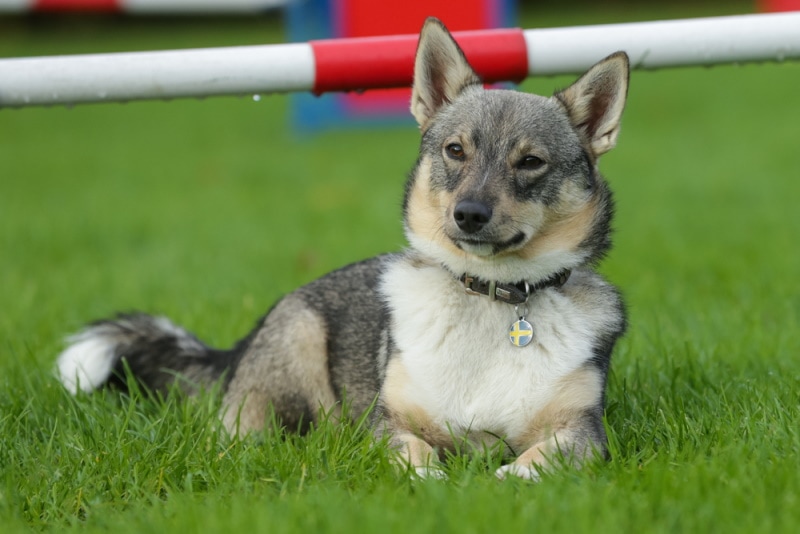Swedish Vallhunds are adorable little dogs that hail from Scandinavia. They are small, stocky, versatile, and fun dogs that appeal to many people. The American Kennel Club calls the Swedish Vallhund “a little Viking farm dog,” and that is a very succinct summary of this breed. Before anyone runs off to purchase a new dog based on a picture they saw online, they should know the potential health issues. Every dog breed is different, and every dog breed has different health concerns to be aware of. The Swedish Vallhund does not have very many health issues, but they do have some significant ones to be aware of.
Here are three Swedish Vallhund health issues to look out for, including the best prevention methods and potential treatments for each one.
The 3 Swedish Vallhund Health Issues
1. Swedish Vallhund Retinopathy
Swedish Vallhunds are prone to a specific genetic disease that affects the health of their eyes. This genetic disease is called Swedish Vallhund retinopathy which is a type of retinopathy that specifically affects this breed. All purebred dogs are at some risk of carrying and passing down specific genetic diseases as a result of breeding. Retinopathy is a degenerative disease that affects the tissue at the back of the Swedish Vallhund’s eyes. At first, signs will manifest as poor vision in low light (when dogs usually have excellent low light vision) and then progress to night blindness before reaching total blindness.

Prevention
Since Swedish Vallhund retinopathy is a genetic disorder, the only way to truly prevent it is to do genetic screenings and prevent dogs from breeding that are potential carriers of the disease. Luckily, according to the American Kennel Club, a genetic test for the eye disease was developed in 2017. This means that responsible breeders have access to the tools they need to screen for and prevent Swedish Vallhund retinopathy.
Treatment
Unfortunately, as of now, there are no effective treatments for Swedish Vallhund retinopathy. There is some nonclinical data to suggest that certain supplements might help strengthen the health of the retina, but no studies have confirmed these findings. If you end up with a Swedish Vallhund with retinopathy, you will have to simply manage their life as they start to lose their eyesight. The good news is that many dogs can adapt to the loss of one of their senses in ways that often amaze humans. As long as you stick to a routine and avoid moving to a new location, your Swedish Vallhund has a good chance of gracefully transitioning to a visually impaired pet.
2. Hip Dysplasia
Hip dysplasia is a deformity that happens during a dog’s growth. Hip dysplasia occurs when the head of the hip and the socket do not grow at equal rates. In most cases, this results in laxity, or looseness, of the hips, which often progresses to degenerative joint disease later in life. Swedish Vallhunds are prone to getting hip dysplasia, along with a large number of other dog breeds.
One of the primary signs of hip dysplasia is weakness in the back legs, which can affect the Swedish Vallhund’s ability to get up and move around. It can also manifest itself as pain in the hip joints. If you see these signs, you should consult your veterinarian because hip dysplasia almost always requires treatment.
Prevention
The best way to prevent hip dysplasia is to screen for it during the breeding process. Hip dysplasia is a genetic disorder that is heavily influenced by environmental factors such as diet, exercise, and growth rate. A reputable breeder should be screening for genetic health conditions, such as hip dysplasia, and ensuring that their puppies are not at a high risk of developing the disease.
Treatment
Veterinarians can identify hip dysplasia quickly during a routine exam, especially if you let them know if you have seen any signs that point toward the disease. Once hip dysplasia has been identified, a treatment plan will be created and issued. In most cases, hip dysplasia is treated by managing your dog’s physical load, strengthening the health of the joints, and managing pain.
Dogs do much better with hip dysplasia if they are at a healthy weight, so your vet might put your dog on a doggy diet. They might also recommend special foods or supplements that help support joint health and strength. Lastly, pain medications might be issued if the disease has progressed to the point where your dog is in chronic pain.
Unfortunately, there is no cure for hip dysplasia as it is an abnormality of the structure of the hip itself. Treatment is all about management as your dog ages.
3. Luxating Patella
A luxating patella is a condition in which a dog’s kneecap pops out of place when pressure is applied in a certain way. There are four grades of luxating patella advancing in severity from one to four (I–IV). Grade I luxating patellas are often very mild, while Grade IV luxations can be debilitating. Swedish Vallhunds are at a mild risk of developing this condition, and it is more common in Swedish Vallhunds with hip dysplasia. If a dog has hip dysplasia, they are already out of alignment, and this misalignment can cause your dog’s gait to become bow legged, which can cause a luxating patella.

Prevention
If a luxating patella is connected to congenital or genetic issues, such as hip dysplasia or a malformation of the bone of the knee itself, then there is no real way to prevent it. However, in some cases, a luxating patella is due to weakness in the ligament and muscle structure of the knee. In that case, you can prevent a luxating patella by ensuring that your Swedish Vallhund remains at a healthy weight (20–35 pounds) and engages in regular low-intensity and low-impact exercise. A healthy weight and exercise will help keep the knees and the muscles in the legs strong, which will help prevent luxation.
Treatment
Depending on the severity of the luxating patella, there are various different treatments. Physical therapy can help with many minor issues connected to a luxating patella. Your vet might also prescribe joint supplements that will target the areas in the knee that are prone to weakening. If the luxation is severe, some vets might suggest surgery to correct the issue. But surgery can be expensive and comes with its own set of risks. If you do not treat luxating patella properly, it can lead to arthritis which can progress until it is debilitating.
 A Good Breeder Is Worth Their Weight in Gold
A Good Breeder Is Worth Their Weight in Gold
Since all of the most alarming health issues found in Swedish Vallhunds are connected to genetics and therefore connected to breeding, an ethical, responsible, and reputable breeder is invaluable. Good breeders should be screening their Swedish Vallhund parents for these genetic diseases. A genetic panel will let a breeder know if a dog is going to be at risk of developing retinopathy and hip dysplasia (which can lead to luxating patella). A responsible breeder will ensure that any dogs that have a concerning genetic panel will not be bred.
Unfortunately, not all breeders are reputable or responsible. If you are looking to buy an American Kennel Club registered Swedish Vallhund, you will likely have to go through a breeder. Make sure the breeder you are using has a good reputation and is actively screening their dogs for genetic issues.
A well-bred Swedish Vallhund should be incredibly healthy and have little to no risk of developing these diseases.

Final Thoughts
Swedish Vallhunds are very healthy dogs overall. They are at risk for a few genetic issues that can easily be screened and bred out by reputable breeders. Even if you have a Vallhund with any one of these issues, they can still live a long and healthy life with the right prevention, diagnosis, and treatment.
- Related Read: How Much Do Swedish Vallhunds Cost?
Featured Image Credit: Marcel van den Bos, Shutterstock




 A Good Breeder Is Worth Their Weight in Gold
A Good Breeder Is Worth Their Weight in Gold






